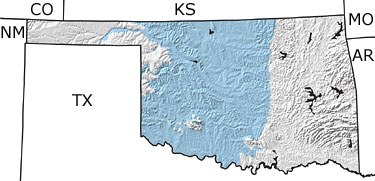Paleontology and geologyPermian rocks are exposed over much of the central portion of Oklahoma. Sand and mud eroding from land exposed in the eastern half of the state were carried by rivers to the sea that covered western Oklahoma during this time. The red color of these sediments is due to the iron oxide compounds deposited within the sand and mud. As the sea began to recede, thick layers of gypsum and salt were deposited, indicative of a warm, dry climate. Fossils of amphibians and reptiles, as well as vertebrate footprints, have been collected from Permian rocks in Oklahoma, but they are rare. Fossil insects are beautifully preserved in lake deposits of north-central Oklahoma. |

